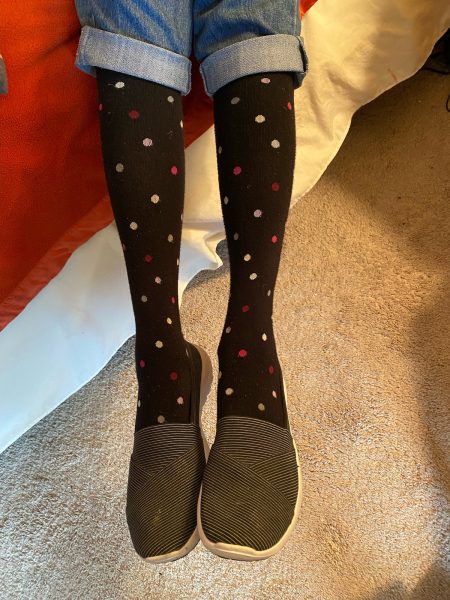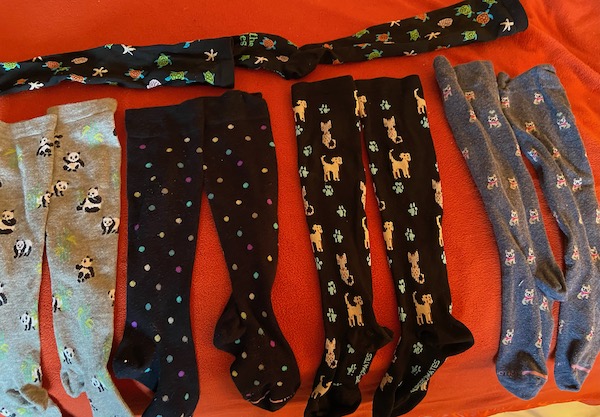A few months ago, I published a post on deep vein thrombosis (DVT) and mentioned the need for some people to wear compression stockings. My sister-in-law Donna wears them because she has a history of developing blood clots. In this picture, she is graciously modeling her new pair of stockings.

Donna was determined to find something other than black or flesh-colored stockings, but in the beginning, it wasn’t an easy task. She’s living out of state, and when my husband and I visited a while back, we did an online search and found lots of places that sold a variety of compression stockings. The trouble was that most had either too few or too many styles to choose from and/or didn’t seem to offer any professional assistance. We lucked out and found a nearby store that had a decent selection and someone to help her make the right choice.
In an attempt to make it easier for someone else who needs compression stockings, I turned to a vein specialist here in Maine for advice — Dr. Cindy Asbjornsen, at Vein Healthcare Center in South Portland.
What are compression stockings and why do people wear them?
First of all, there are several kinds of compression garments, including tights, leggings, shorts, arm sleeves, gloves, bandages, and, of course, stockings. The purpose of them all is to apply pressure to veins in order to improve circulation. In this post, I’m going to focus on compression stockings because according to Dr. Asbjornsen, they are “The most common form of compression therapy.”
My sister-in-law wears them to reduce her risk of developing clots in the veins in her legs. The risk is that they could travel to her lungs and cause a heap of trouble. The stockings can also be helpful in treating other venous diseases, such as varicose veins, and in reducing edema or swelling in the legs.

Dr. Asbjornsen also recommends compression stockings for anyone who’s on their feet for extended periods. She often wears compression socks or stockings at work because she’s almost always on her feet. In her case, she’s trying to stop venous disease before it even has a chance to start. Wearing them also makes her legs feel more comfortable during, as well as, at the end of a long day.
Choosing the right compression stocking
As Donna discovered, you can find compression stockings in a lot of places, including online and in big box stores and local pharmacies. But finding something that’s right for you can be hit or miss. She had a prescription from her doctor, but it only said what strength the stockings should be. Legally, you don’t need a prescription to buy compression garments, but if you have one, it should clearly explain the diagnosis, the style of stocking being recommended, and the clinical level of compression.
The best-case scenario is to consult a vein specialist and get a recommendation for a certified orthotic fitter or someone who has expertise in fitting compression garments.
Understanding compression levels
Compression stockings come in different strengths. The stronger they are the tighter the compression. The strength is measured in millimeters of mercury (mmHg), the same scale used to measure your blood pressure.
I found information about different compression levels at Sigvaris, a company that sells a brand of compression stockings that Dr. Asbjornsen says is “a good one”.
8-15 mmHg
- Mildly aching and tired legs
- Support and comfort for either standing or sitting for long periods
- When just a little support is needed for general health and energy
15-20 mmHg
- Slightly more support, offering day-to-day relief from achy, heavy, slightly swollen legs
- Extra support on busy, active days, or when traveling
- An aid for enhanced circulation, especially in the legs
- During pregnancy, they can help prevent varicose and spider veins
20-30 mmHg
- The most commonly prescribed compression level by doctors
- Used to help a variety of minor to moderate medical conditions
- Used to help chronically painful, heavily fatigued legs
- Helpful in the treatment of varicose veins
- Relief from the swelling associated with mild edema
- Used in combination with elective surgical procedures such as sclerotherapy and phlebectomy
- Used to help treat orthostatic/postural hypotension, a form of low blood pressure
30-40 mmHg
- Relief from moderate and severe edema and lymphedema
- Helps prevent and relieve more serious cases of varicose veins
- Used in the treatment of deep vein thrombosis (DVT) and post-thrombotic syndrome
- Can help heal active venous stasis ulcers
- Used after bone fractures and orthopedic surgeries
- Used to treat phlebitis
- Used in treating skin changes with healed ulceration
40-50 mmHg
- Used as part of the treatment for chronic venous insufficiency
- Used for the most severe cases of DVT and post-thrombotic syndrome
- Used in treating severe skin changes with active ulceration
What are they made of?
Compression stockings are made from a variety of materials, including cotton, spandex, nylon, and wool. The type and combination of material and their thickness help determine not only much compression you’ll get but how they’ll feel when you’re wearing them.
I learned to pay attention to the label when I unwittingly bought Donna a really cool pair only to find out they contained wool and she couldn’t wear them because she’s allergic. Luckily, I was able to lend them to my sister, who just had knee replacement surgery and has to wear compression stockings for a while.
Another thing to know is that Dr. Asbjornsen is a huge advocate of what she calls graduated compression. Here’s what that means:
The pressure is highest at the foot and ankle and gradually decreases as the garment rises up the leg. This pressure gradient makes it easier for the body to pump blood up towards the heart and more difficult for gravity to pull blood downward.
Dr. Cindy Asbjornsen, Vein Specialist, Vein Health Center

You may have to try out different styles before you settle on what works best for you, so make sure you know the store’s return policy. And don’t be shy about asking questions. Donna was looking at two different types of stockings, which were the same strength, but one pair felt lighter than the other. She was leaning toward the lighter ones, but the person helping her said they tended to be more difficult to get on and off, so she should try the heavier style first. It turned out to be a good suggestion.
If you’d like to learn more about compression therapy for venous disease, there’s some great information in Vein Health News, a magazine Dr. Asbjornsen publishes for primary care physicians.
If you need help choosing compression stockings and live in the greater Portland, Maine area, here are two stores to consider:
- MedCor (Scarborough)
- A Special Place (Portland)
On the Sigvaris website, you can also do a search for a store in or near your community that carries their brand.
If you have any additional questions or information you think might be helpful, please let us know in the comment section below.

Great explanation of a timely (for me) topic.
Thank you Diane, this was helpful information that I can pass on to some friends.
I had vein stripping back in 2001, and I’ve been wearing compression knee socks ever since. They really help. At first I used ones I got at at pharmacy in Portland, ME. But, they started to wear out, and I discovered Dr. Motion compression stockings at Kohls. I get the ones with the padded foot. They are reasonably priced. I find they do the trick and don’t bind.